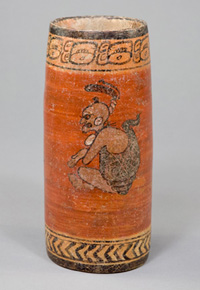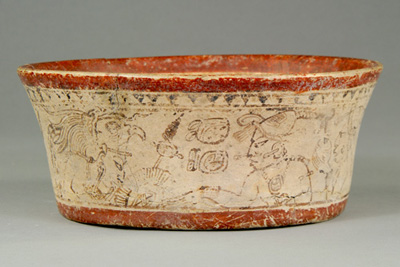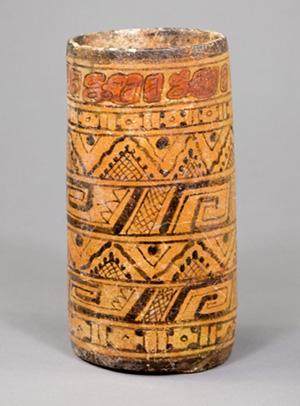The inventory of Maya ceramic art provided here is based on six months study of the entire collections of Maya pottery in storage and on exhibit at the Museo Popol Vuh, as well as a survey of pottery in storage in the basement of the Museo Nacional de Arqueologia circa 1994. That same year a survey was also undertaken in the main ceramic bodega at Tikal. Combined with these considerable sources, the following directory is also based on notes and an estimated 30,000 photographs from scores of museums around the world from Australia to Zurich, plus collections throughout America and Europe (the FLAAR Photo Archive).
This particular list is a revised version (July 1999) of lecture abstracts for archaeology and art history lectures delivered by Dr Hellmuth at the Museo Popol Vuh, Universidad Francisco Marroquin, during 1997. The descriptions reflect to some degree the chapter headings and abstract for Hellmuth's newest book on Maya ceramic art and iconography which is now finished and has entered editing stage.
The categories here also reflect a new course which Professor Hellmuth is preparing for an projected seminar on these subjects. A glossary is being prepared to introduce more information for some of the art, archaeological, and iconographic jargon.
One thousand years of Maya pottery will be covered, from roughly 1 A.D. (Preclassic) to 1000 A.D. (Post Classic).
The precis of Maya ceramic art which follows goes beyond the traditional ceramic sequence and includes connoisseurship, aesthetics, iconography, and epigraphy. Connoisseurship and aesthetics are those aspects of art history which have been neglected by anthropology. Maya potters, scribes, and associated artists of ancient Guatemala produced beautiful works of art which can be appreciated for their style, proportions, and craftsmanship (in addition to the archaeological concerns of rim profile and ware).
Iconography is the study of meaning in art, specifically to learn to recognize how to identify the different Maya deities and mythical monsters. For example, whereas Chac had a long nose, not all long-nosed deities are Chac. The so-called "Chac" on Tikal's North Acropolis is actually the head of the Principal Bird Deity. A complete definition of iconography, in the sense of iconography within Maya studies, is provided on a separate page dedicated to iconography and in my PhD dissertation.
Epigraphy is the study of the meaning of hieroglyphic writing. Many Mayan hieroglyphs are on Late Classic vases, bowls, and plates, and we can easily learn the key hieroglyphs, such as the word for cacao. But from the perspective of an art historian and archaeologist, there are a variety of aspects of the hieroglyphic inscriptions that can be addresses before an epigrapher takes over with a technical lecture on phoneticism. There is, therefore, no need to exclude a discussion of the hieroglyphs from an analysis of the type-variety and ceramic sequence. The calligraphy is just as much a part of the ceramic artifact as the rim profile, paste, and surface slip.
Some of the themes which will be discussed during this survey of advances in Maya archaeology will include:
One kind of PRECLASSIC MAYA pottery is readily recognized by the parallel multiple brush strokes, named Usulutan Ware after the area of El Salvador where this pottery is most popular. This style spread throughout the Peten and magnificent examples are known for Tikal. An especially attractive kind of bowl features a flange at or near the rim or a flange elsewhere high on the sidewall which is arranged to form the silhouette of a fish, bat, or other creature. These Preclassic bowls, dishes, or plate-like forms come in a wide range of size and shape over the Maya area.
Glossy orange ware, with a slippery finish, is another hallmark of Preclassic pottery from the Maya area of southern Mexico, all Guatemala and Belize, but not frequent in Honduras. Erect chimney-like spouts are another hallmark of later Preclassic pottery shape. The National Museum of Archaeology and Ethnology has many fine specimens as does the museum at Tikal itself.
The PROTOCLASSIC is the time period when the Maya begin painting human figures, deities, and animals on their pottery. The Protoclassic is easy to recognize by the breast-shaped supports, known as mammiform pottery. Potstands are another diagnostic trait. Spouts still continue from the Preclassic.
During the transition from the Protoclassic into the EARLY CLASSIC, two new forms of support develop. One is a globular support, where the former nipple expands in width to equal the size of the (former) breast itself. The potters continue to experiment with the same size of support by creating an additional variant of the earlier mammiform kind, in the form of peccary heads. These peccary heads gradually replace the breast-shaped supports. You can see several peccary-shaped supports in my PhD dissertation.
Further into the Early Classic, large wide-mouthed bowls feature a flange of clay around the lower sidewall. These are known to archaeologists as basal flange bowls. This class of wide bowl develops into the hallmark of the entire Early Classic period. In the subsequent Late Classic period this form of dish is replaced by the basic Maya plate, usually with three supports.
Later into the Early Classic, by the 4th century A.D., the Mexican style of cylindrical tripod is introduced from Teotihuacan outposts throughout the Tiquisate area of Escuintla. This style takes over Kaminaljuyu and moves into the Peten.
Early Classic Tiquisate pottery features a mixture of local Escuintla motifs, foreign Teotihuacan motifs, and designs borrowed from neighboring Maya areas (the inhabitants of Escuintla in the 4th-6th centuries A.D. were not Mayan). The Teotihuacan features have been well publicized, but an entire sub-style has gone unheralded, the "Red and Cream Bichrome." This part red part off-white pottery was fashioned into cylindrical tripods, bowls, and animal effigy figures. The Museo Popol Vuh has an exceptionally fine collection of varied and attractive forms and proportions of Red and Cream Bichrome.
ANIMAL EFFIGY containers, but in blackware, also appear at this time in Kaminaljuyu and throughout the Peten, mostly in the Uaxactun, El Zotz, and Tikal areas. These are rare but of considerable aesthetic beauty due to their fully three-dimensional form. Dogs, humans, deities and occasionally birds are the usual subjects for this effigies. They are nicknamed "cookie jars" because they have lids and are about the overall size of modern cookie jars.
CACHE VESSELS are monumental ceramic displays of elite mythical characters. These cache vessels mimic the giant stucco masks which decorate pyramid terraces of the same Early Classic period at Tikal and Uaxactun. The identical designs as on Cache Vessels are also found on Tikal Stela 2. A dozen cache vessels are presented in my PhD work. Then in the Late Classic artists at Palenque do a revival style of their new manner of presenting the characters that were common in central Peten a center or so earlier.
As the Early Classic fades out and the LATE CLASSIC styles come into favor, PLATES replace basal flange bowls and hemispherical bowls replace cylindrical tripods. In a few generations VASES begin to predominate the art scene of 7th century Peten. These magnificent polychrome vases, produced from the 7th through 9th centuries, have received almost all the attention of iconographic analysis from 1973 through today. What has been ignored are the bowls of the 6th century, the predecessors of the vases. Since the Museo Popol Vuh has an outstanding collection of Tepeu 1 bowls, we will feature this neglected ceramic category in the slide shows.
Although Tepeu 1 bowls do include scenes with deities and animals, tableaux of actual people in historical settings are rare, except for elaborate rituals such as the enema ritual (the most common on Late Classic pottery in general and on Tepeu 1 bowls in particular). Instead, Tepeu 1 bowls are the main vehicle for the Primary Standard Sequence of hieroglyphs (abbreviated the PSS). Tepeu 1 bowls of hemispherical shape and flat-bottomed bowls of the ensuing Tepeu 2 times are also the main display area for simple design motifs and basic decorations (that means designs with no or at least few full-figure animals or people).
TERMINAL CLASSIC ceramics are best known from Seibal, Altar de Sacrificios, and related regions of Peten. These 9th century pots with figural scenes provide eye-witness portraits of the barbarian warriors who usurped power from local Maya rulers. This Fine Orange pottery (pottery with no temper) is considered to come into Guatemala from the Tabasco and Campeche frontiers. This class of Pabellon Modeled Carved and Balancan Fine Orange bowls and vases, both imports and local variations) was used by the last inhabitants of Tikal, Uaxactun, Yaxha, and all the great Maya city-states of the Peten. Comparable Terminal Late Classic pottery is also known for the Highlands. Although this class of pottery is mold-impressed, carved, or gouged (not painted at all) there are also other Tepeu 3 vases still being painted in polychrome, though these are very rare: Tikal produced only two or three in many years excavation.
Outside the traditional areas of Lowland Peten, other regions of Guatemala deserve attention as well, as potters produced lovely works of art everywhere. Late Classic Tiquisate art is such an example, most notably vases with carved designs and glossy painted surfaces. Late Classic Tiquisate Ware featured predominently moldmade decoration. During this time period there is no more Teotihuacan influence in the ceramic art throughout Escuintla.
MOTAGUA VALLEY: this area produced remarkable ceramic art, varying from pure Classic Maya to carved scenes that share more with the non-Maya Escuintla area. Since not much is published about this area, I have learned considerably from research on pottery of the the Middle Motagua area from Dr Guillermo Mata, especially about mammiform-supported Protoclassic pottery. Later potters of the Motagua valley also favored Highland Styles, including a style featuring God D, God K, and the Hero Twins painted in the same colors as favored in the fully Highland Chama Style. The Motagua people were only 50 km from Copan so it is not surprising that they share some styles with Honduras, including a heavy, deeply impressed molded vase style. A further curiosity of the Motagua Maya is that they shared several key styles with the Maya of Central Peten. For example, the ruling family of Late Classic Tikal favored carved Motagua pottery for their royal burials, such as in Burial 116 under Temple I (Ruler A). One of his sons, which I unearthed at Tikal in 1965 in Burial 196 (Tomb of the Jade Jaguar), under Str. 5D-73, had more than nine vases carved in a Peten variant of the Motagua manner with the non-carved areas highlighted in pastel colored painted stucco.
 |
Unnamed Late Classic polychrome style vase from Belize or Guatemala, shows a image wtih God N inside his traditional conch shell. Photograph: La Ruta Maya permission. |
CHAMA is a well known style. A recent discovery is that the Repeated Bat Glyph style is directly associated with the Chama style. The Highland God D-God K Style is a local variant of the Chama style which was popular in the middle Motagua Valley. This Highland God D style has no chevron banding but otherwise shares several key attributes with the associated Chama style.
The NEBAJ Style was, after the Chama Style, the greatest achievement of Maya scribes and painters of the Late Classic period. Pots of this Highland style are very rarely encountered.
The Dark Red Highland Style: not much is known about pottery of this regional style. Its home may have been around Huehuetenango, but if we had more examples it might be possible to reassess this tentative estimate.
The CHIPOC Style of Highland Pottery was entirely gouged (not painted) but the background alternated in panels between black and white. The Museo Popol Vuh has an especially fine collection of Chipoc Style pottery. God N and the Maize God were the favored subjects on Chipoc pots.
For the great painting styles of lowland Peten, the Codex Style is the best known. Actually many other styles were produced during this same century: Fine Incised Style, Varnished Wood Style, Pink Hieroglyph Style. For Tepeu 1 times you can detect the Red-Orange Double PSS Style, Black-Maroon Double PSS Style, as well as additional regional and temporal styles.
Of the Codex Style the main importance is to distinguish the variations, such as the black-background Codex Style, the Brown-Wash Codex Style, the red-highlighted variant, and others.
 |
|
Codex Style from the Maya Lowlands. Photograph with permission of La Ruta Maya Foundation. |
Some regional workshops produced pottery only in certain colors. In a few cases special colors were reserved for the production of an independent series, such as "Catfish Red Style." In other cases the colors favored in a region were used on all sizes and shapes of pottery, such as the color "Holmul Orange." All these features make it possible to determine precisely what origin is the source for a pot just on the basis of color. In other cases the design alone reveals the source: cockroaches, for example, were most popular in the Tikal and Uaxactun area.
 |
GEOMETRIC and ABSTRACT designs have been neglected in the rush to publish fancy throne scenes. This means that simple Maya vases with no human figures and not even animals have been neglected. But these non-figural decorative vases represent more than 50% of the elite ceramic output. Even the burials of the great kings of Tikal had more polychrome pots with "simple" designs than with elaborate throne scenes. Thus this series of lectures will include representative samples of Late Classic Peten Maya vases with banded, zoned, checkerboard, and related decorations.
 |
| Geometric design, FLAAR photography, permission courtesy of the La Foundacion Ruta Maya. |
Updated August 16, August, 2010. New page format posted November 17, 2009.
Edited July 18, 1999; links added March 5, 2000.